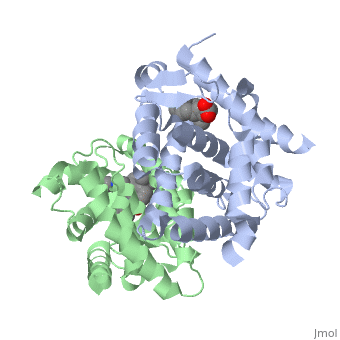1dkf
From Proteopedia
CRYSTAL STRUCTURE OF A HETERODIMERIC COMPLEX OF RAR AND RXR LIGAND-BINDING DOMAINS
Structural highlights
Disease[RARA_HUMAN] Note=Chromosomal aberrations involving RARA are commonly found in acute promyelocytic leukemia. Translocation t(11;17)(q32;q21) with ZBTB16/PLZF; translocation t(15;17)(q21;q21) with PML; translocation t(5;17)(q32;q11) with NPM. The PML-RARA oncoprotein requires both the PML ring structure and coiled-coil domain for both interaction with UBE2I, nuclear microspeckle location and sumoylation. In addition, the coiled-coil domain functions in blocking RA-mediated transactivation and cell differentiation. Function[RXRA_MOUSE] Receptor for retinoic acid. Retinoic acid receptors bind as heterodimers to their target response elements in response to their ligands, all-trans or 9-cis retinoic acid, and regulate gene expression in various biological processes. The RAR/RXR heterodimers bind to the retinoic acid response elements (RARE) composed of tandem 5'-AGGTCA-3' sites known as DR1-DR5. The high affinity ligand for RXRs is 9-cis retinoic acid. RXRA serves as a common heterodimeric partner for a number of nuclear receptors. The RXR/RAR heterodimers bind to the retinoic acid response elements (RARE) composed of tandem 5'-AGGTCA-3' sites known as DR1-DR5. In the absence of ligand, the RXR-RAR heterodimers associate with a multiprotein complex containing transcription corepressors that induce histone acetylation, chromatin condensation and transcriptional suppression. On ligand binding, the corepressors dissociate from the receptors and associate with the coactivators leading to transcriptional activation. The RXRA/PPARA heterodimer is required for PPARA transcriptional activity on fatty acid oxidation genes such as ACOX1 and the P450 system genes.[1] [2] [3] [RARA_HUMAN] Receptor for retinoic acid. Retinoic acid receptors bind as heterodimers to their target response elements in response to their ligands, all-trans or 9-cis retinoic acid, and regulate gene expression in various biological processes. The RXR/RAR heterodimers bind to the retinoic acid response elements (RARE) composed of tandem 5'-AGGTCA-3' sites known as DR1-DR5. In the absence of ligand, the RXR-RAR heterodimers associate with a multiprotein complex containing transcription corepressors that induce histone acetylation, chromatin condensation and transcriptional suppression. On ligand binding, the corepressors dissociate from the receptors and associate with the coactivators leading to transcriptional activation. RARA plays an essential role in the regulation of retinoic acid-induced germ cell development during spermatogenesis. Has a role in the survival of early spermatocytes at the beginning prophase of meiosis. In Sertoli cells, may promote the survival and development of early meiotic prophase spermatocytes. In concert with RARG, required for skeletal growth, matrix homeostasis and growth plate function (By similarity). Regulates expression of target genes in a ligand-dependent manner by recruiting chromatin complexes containing MLL5. Mediates retinoic acid-induced granulopoiesis.[4] [5] [6] [7] Evolutionary ConservationCheck, as determined by ConSurfDB. You may read the explanation of the method and the full data available from ConSurf. Publication Abstract from PubMedThe crystal structure of a heterodimer between the ligand-binding domains (LBDs) of the human RARalpha bound to a selective antagonist and the constitutively active mouse RXRalphaF318A mutant shows that, pushed by a bulky extension of the ligand, RARalpha helix H12 adopts an antagonist position. The unexpected presence of a fatty acid in the ligand-binding pocket of RXRalpha(F318A is likely to account for its apparent "constitutivity." Specific conformational changes suggest the structural basis of pure and partial antagonism. The RAR-RXR heterodimer interface is similar to that observed in most nuclear receptor (NR) homodimers. A correlative analysis of 3D structures and sequences provides a novel view on dimerization among members of the nuclear receptor superfamily. Crystal structure of a heterodimeric complex of RAR and RXR ligand-binding domains.,Bourguet W, Vivat V, Wurtz JM, Chambon P, Gronemeyer H, Moras D Mol Cell. 2000 Feb;5(2):289-98. PMID:10882070[8] From MEDLINE®/PubMed®, a database of the U.S. National Library of Medicine. See Also
References
| ||||||||||||||||||||
Categories: Human | Large Structures | Lk3 transgenic mice | RCSB PDB Molecule of the Month | Vitamin D Receptor | Bourguet, W | Chambon, P | Gronemeyer, H | Moras, D | SPINE, Structural Proteomics in Europe | Vivat, V | Wurtz, J M | Helical sandwich | Heterodimer | Hormone-growth factor receptor complex | Hormone/growth factor receptor | Protein-ligand complex | Spine | Structural genomic | Structural proteomics in europe


